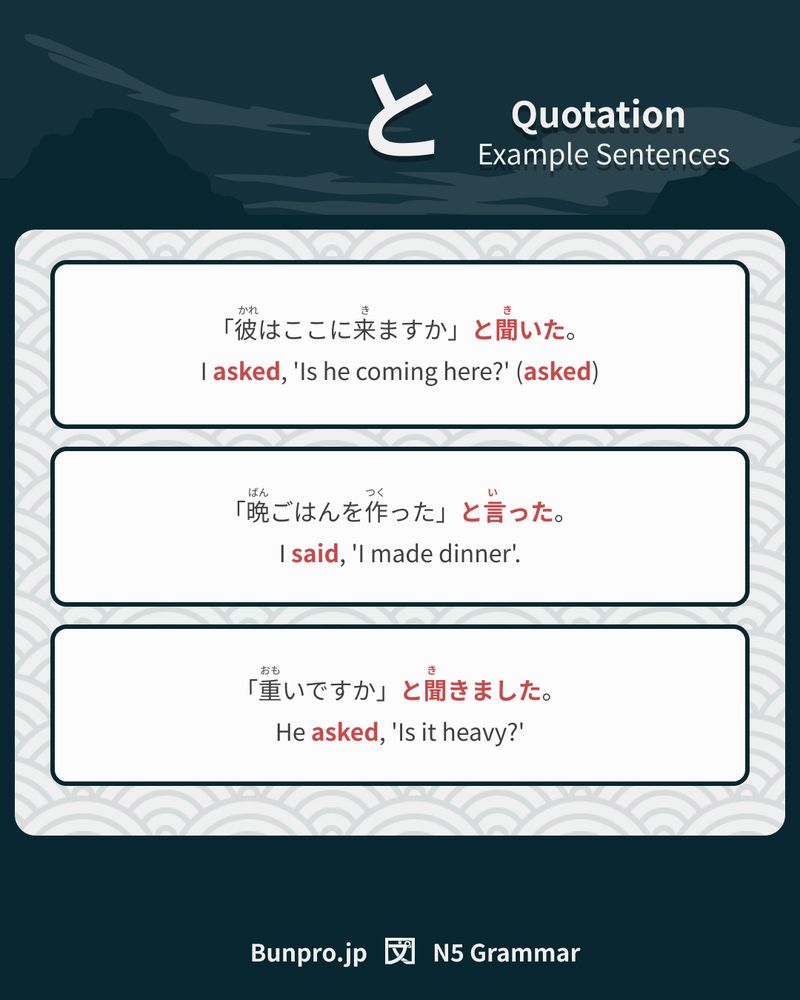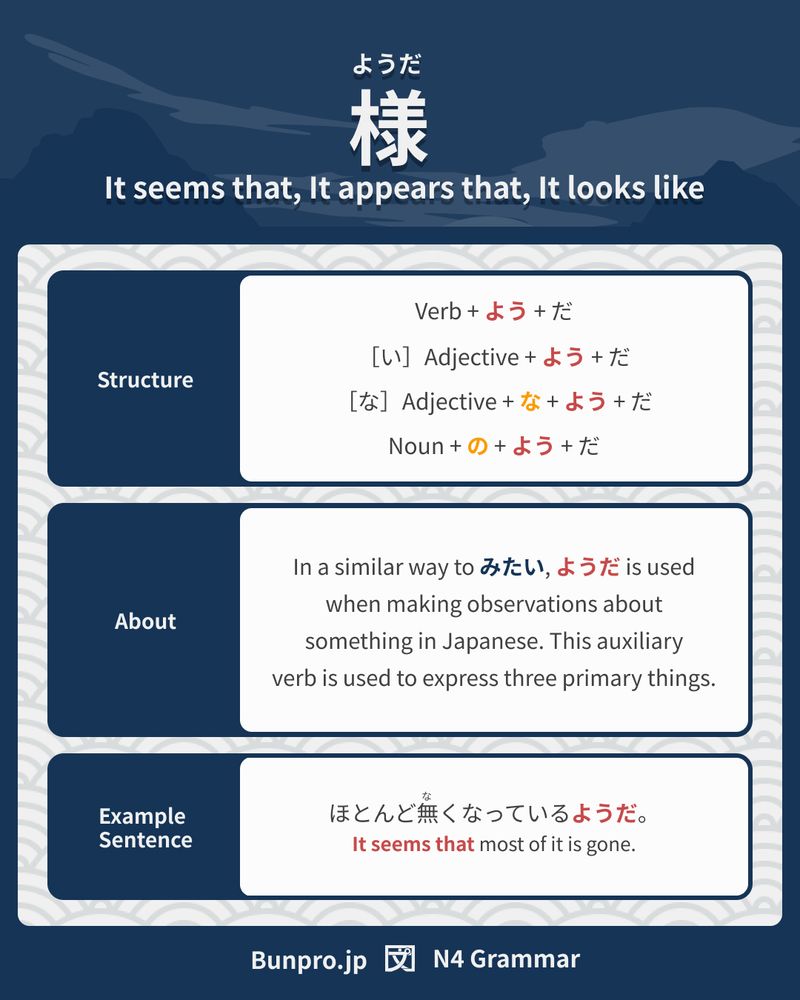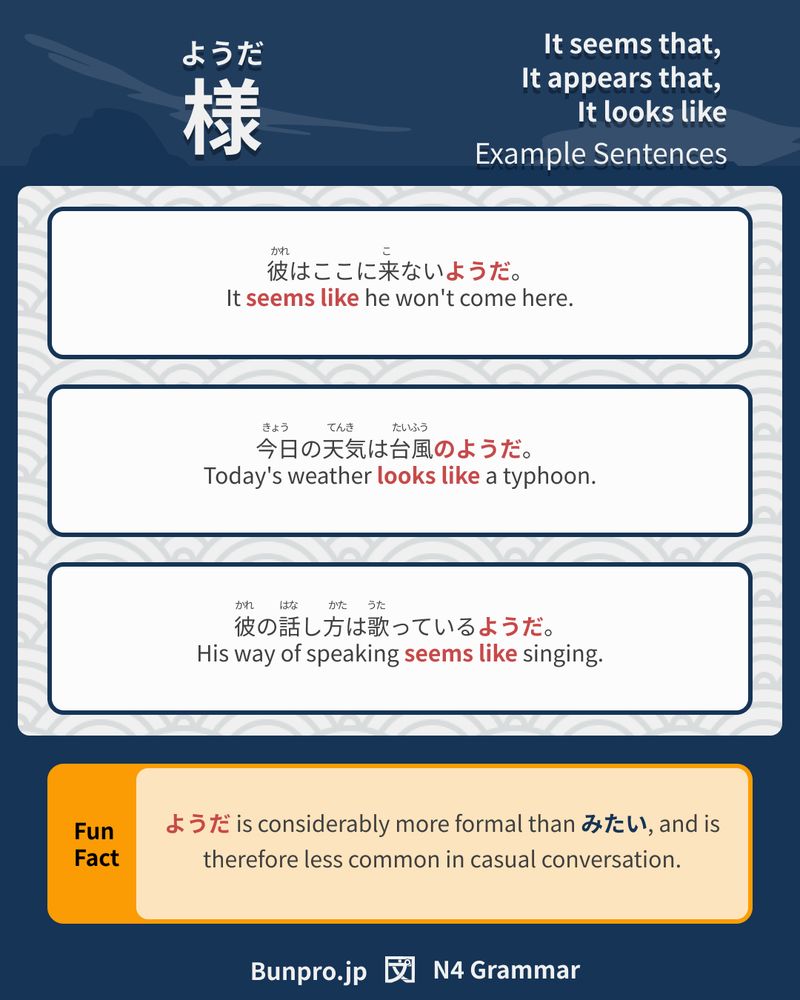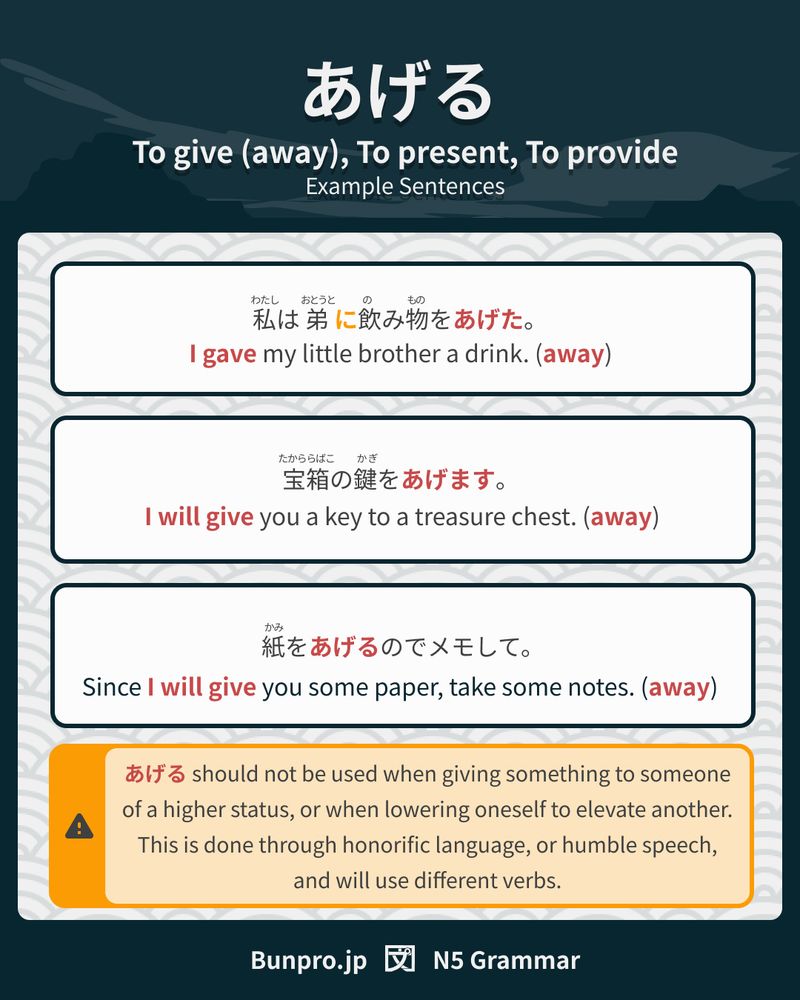The #Japanese 〜ている -te iru form expresses ongoing actions. 勉強しています。 Benkyō shite imasu. I am studying. #JapaneseGrammar #JapaneseVerbs #LearnJapanese. Click to learn more. thelanguagegarage.com/japanese-te-...

October 15, 2025 at 9:32 PM
The #Japanese 〜ている -te iru form expresses ongoing actions. 勉強しています。 Benkyō shite imasu. I am studying. #JapaneseGrammar #JapaneseVerbs #LearnJapanese. Click to learn more. thelanguagegarage.com/japanese-te-...
📘 N4 Grammar: 「ずっと」 ✨
ずっと (zutto) = continuously, all the time, ever since
例文:
朝からずっと忙しいです。
(Asa kara zutto isogashii desu.)
= I’ve been busy since morning.
#LearnJapanese #JapaneseGrammar #JLPTN4 #Bunpro #JapaneseLearning #Nihongo #StudyJapanese
ずっと (zutto) = continuously, all the time, ever since
例文:
朝からずっと忙しいです。
(Asa kara zutto isogashii desu.)
= I’ve been busy since morning.
#LearnJapanese #JapaneseGrammar #JLPTN4 #Bunpro #JapaneseLearning #Nihongo #StudyJapanese


September 19, 2025 at 4:43 AM
📘 N4 Grammar: 「ずっと」 ✨
ずっと (zutto) = continuously, all the time, ever since
例文:
朝からずっと忙しいです。
(Asa kara zutto isogashii desu.)
= I’ve been busy since morning.
#LearnJapanese #JapaneseGrammar #JLPTN4 #Bunpro #JapaneseLearning #Nihongo #StudyJapanese
ずっと (zutto) = continuously, all the time, ever since
例文:
朝からずっと忙しいです。
(Asa kara zutto isogashii desu.)
= I’ve been busy since morning.
#LearnJapanese #JapaneseGrammar #JLPTN4 #Bunpro #JapaneseLearning #Nihongo #StudyJapanese
Understanding は vs が in Japanese!
は = sets the topic
が = highlights what’s being described
This reel uses cats to make the difference super clear.
⚠️ Press and hold to pause
✍️ Try your own sentence—did you use は or が?
#LearnJapanese #JapaneseGrammar #Bunpro #JLPTN5 #StudyJapanese
は = sets the topic
が = highlights what’s being described
This reel uses cats to make the difference super clear.
⚠️ Press and hold to pause
✍️ Try your own sentence—did you use は or が?
#LearnJapanese #JapaneseGrammar #Bunpro #JLPTN5 #StudyJapanese
May 17, 2025 at 1:25 PM
Understanding は vs が in Japanese!
は = sets the topic
が = highlights what’s being described
This reel uses cats to make the difference super clear.
⚠️ Press and hold to pause
✍️ Try your own sentence—did you use は or が?
#LearnJapanese #JapaneseGrammar #Bunpro #JLPTN5 #StudyJapanese
は = sets the topic
が = highlights what’s being described
This reel uses cats to make the difference super clear.
⚠️ Press and hold to pause
✍️ Try your own sentence—did you use は or が?
#LearnJapanese #JapaneseGrammar #Bunpro #JLPTN5 #StudyJapanese
To conjugate a #Japanese godan verb, remove –u and and add –imasu. (Change the final う –u line character to the corresponding い -i line character and add ます –masu. #JapaneseGrammar #LearnJapanese #Languages. Learn more: thelanguagegarage.com/japanese-non...

July 18, 2025 at 4:11 PM
To conjugate a #Japanese godan verb, remove –u and and add –imasu. (Change the final う –u line character to the corresponding い -i line character and add ます –masu. #JapaneseGrammar #LearnJapanese #Languages. Learn more: thelanguagegarage.com/japanese-non...
✨【のが上手】means “to be good at (doing)” in Japanese!
Just use: Verb + の + が + 上手
例:
・料理をするのが上手!
・サッカーをするのが上手!
⚠️ Don’t use it about yourself, it sounds a bit proud!
Use 得意 (とくい) instead if you want to be modest.
#Bunpro #LearnJapanese #JLPTN5 #JapaneseGrammar
Just use: Verb + の + が + 上手
例:
・料理をするのが上手!
・サッカーをするのが上手!
⚠️ Don’t use it about yourself, it sounds a bit proud!
Use 得意 (とくい) instead if you want to be modest.
#Bunpro #LearnJapanese #JLPTN5 #JapaneseGrammar


July 21, 2025 at 12:23 PM
✨【のが上手】means “to be good at (doing)” in Japanese!
Just use: Verb + の + が + 上手
例:
・料理をするのが上手!
・サッカーをするのが上手!
⚠️ Don’t use it about yourself, it sounds a bit proud!
Use 得意 (とくい) instead if you want to be modest.
#Bunpro #LearnJapanese #JLPTN5 #JapaneseGrammar
Just use: Verb + の + が + 上手
例:
・料理をするのが上手!
・サッカーをするのが上手!
⚠️ Don’t use it about yourself, it sounds a bit proud!
Use 得意 (とくい) instead if you want to be modest.
#Bunpro #LearnJapanese #JLPTN5 #JapaneseGrammar
そう = Looks like / Seems 👀
Use it to describe appearances:
✔ Verb stem + そう
✔ い-adj (drop い) + そう
✔ な-adj + そう
🍜 食べ物が食べやすそう
Tabemono ga tabeyasou = Looks easy to eat
What’s something that looks fun or looks difficult to you? 👇
#JapaneseGrammar #Bunpro #JLPT #LearnJapanese #そう #JapaneseStudy
Use it to describe appearances:
✔ Verb stem + そう
✔ い-adj (drop い) + そう
✔ な-adj + そう
🍜 食べ物が食べやすそう
Tabemono ga tabeyasou = Looks easy to eat
What’s something that looks fun or looks difficult to you? 👇
#JapaneseGrammar #Bunpro #JLPT #LearnJapanese #そう #JapaneseStudy


May 30, 2025 at 12:08 AM
そう = Looks like / Seems 👀
Use it to describe appearances:
✔ Verb stem + そう
✔ い-adj (drop い) + そう
✔ な-adj + そう
🍜 食べ物が食べやすそう
Tabemono ga tabeyasou = Looks easy to eat
What’s something that looks fun or looks difficult to you? 👇
#JapaneseGrammar #Bunpro #JLPT #LearnJapanese #そう #JapaneseStudy
Use it to describe appearances:
✔ Verb stem + そう
✔ い-adj (drop い) + そう
✔ な-adj + そう
🍜 食べ物が食べやすそう
Tabemono ga tabeyasou = Looks easy to eat
What’s something that looks fun or looks difficult to you? 👇
#JapaneseGrammar #Bunpro #JLPT #LearnJapanese #そう #JapaneseStudy
PART 2
【JLPT N5 – と vs も】
Ever mix these up? 🤔
Let’s make it simple:
🔴 と (to) = “and” or “with”
👧 友だちと遊ぶ = to play with a friend
🔵 も (mo) = “also” or “too”
👨💼 田中さんも来ました = Tanaka came too
#Bunpro #Bunprosrs #LearnJapanese #JapaneseGrammar #Nihongo #JLPTN5 #JapaneseStudy #日本語
【JLPT N5 – と vs も】
Ever mix these up? 🤔
Let’s make it simple:
🔴 と (to) = “and” or “with”
👧 友だちと遊ぶ = to play with a friend
🔵 も (mo) = “also” or “too”
👨💼 田中さんも来ました = Tanaka came too
#Bunpro #Bunprosrs #LearnJapanese #JapaneseGrammar #Nihongo #JLPTN5 #JapaneseStudy #日本語



June 28, 2025 at 2:41 AM
PART 2
【JLPT N5 – と vs も】
Ever mix these up? 🤔
Let’s make it simple:
🔴 と (to) = “and” or “with”
👧 友だちと遊ぶ = to play with a friend
🔵 も (mo) = “also” or “too”
👨💼 田中さんも来ました = Tanaka came too
#Bunpro #Bunprosrs #LearnJapanese #JapaneseGrammar #Nihongo #JLPTN5 #JapaneseStudy #日本語
【JLPT N5 – と vs も】
Ever mix these up? 🤔
Let’s make it simple:
🔴 と (to) = “and” or “with”
👧 友だちと遊ぶ = to play with a friend
🔵 も (mo) = “also” or “too”
👨💼 田中さんも来ました = Tanaka came too
#Bunpro #Bunprosrs #LearnJapanese #JapaneseGrammar #Nihongo #JLPTN5 #JapaneseStudy #日本語
📝 JLPT N5 Grammar: ~てもいい
Use it to say something’s OK, allowed, or even if ~ it’s fine!
📌 誰でもいい – Anyone is fine
📌 高くてもいい – It’s fine even if it’s expensive
Try it yourself 👇
#JapaneseGrammar #LearnJapanese #Bunpro #JLPTN5 #日本語勉強中
Use it to say something’s OK, allowed, or even if ~ it’s fine!
📌 誰でもいい – Anyone is fine
📌 高くてもいい – It’s fine even if it’s expensive
Try it yourself 👇
#JapaneseGrammar #LearnJapanese #Bunpro #JLPTN5 #日本語勉強中


June 9, 2025 at 12:52 AM
📝 JLPT N5 Grammar: ~てもいい
Use it to say something’s OK, allowed, or even if ~ it’s fine!
📌 誰でもいい – Anyone is fine
📌 高くてもいい – It’s fine even if it’s expensive
Try it yourself 👇
#JapaneseGrammar #LearnJapanese #Bunpro #JLPTN5 #日本語勉強中
Use it to say something’s OK, allowed, or even if ~ it’s fine!
📌 誰でもいい – Anyone is fine
📌 高くてもいい – It’s fine even if it’s expensive
Try it yourself 👇
#JapaneseGrammar #LearnJapanese #Bunpro #JLPTN5 #日本語勉強中
📛【〜てはいけない = Must not / May not】📛
Use this grammar when something is strictly forbidden!
Form: Verb[て]+ はいけない
🧠 Example:
そこに入ってはいけない。
Soko ni haitte wa ikenai.
You must not go in there.
It’s a polite way to say NO 🚫
#JapaneseGrammar #Bunpro #JLPTN5 #LearnJapanese #にほんご #日本語 #DailyJapanese
Use this grammar when something is strictly forbidden!
Form: Verb[て]+ はいけない
🧠 Example:
そこに入ってはいけない。
Soko ni haitte wa ikenai.
You must not go in there.
It’s a polite way to say NO 🚫
#JapaneseGrammar #Bunpro #JLPTN5 #LearnJapanese #にほんご #日本語 #DailyJapanese


July 10, 2025 at 9:49 AM
📛【〜てはいけない = Must not / May not】📛
Use this grammar when something is strictly forbidden!
Form: Verb[て]+ はいけない
🧠 Example:
そこに入ってはいけない。
Soko ni haitte wa ikenai.
You must not go in there.
It’s a polite way to say NO 🚫
#JapaneseGrammar #Bunpro #JLPTN5 #LearnJapanese #にほんご #日本語 #DailyJapanese
Use this grammar when something is strictly forbidden!
Form: Verb[て]+ はいけない
🧠 Example:
そこに入ってはいけない。
Soko ni haitte wa ikenai.
You must not go in there.
It’s a polite way to say NO 🚫
#JapaneseGrammar #Bunpro #JLPTN5 #LearnJapanese #にほんご #日本語 #DailyJapanese
✨【けれども = but / although】✨
The formal version of けど — used to show contrast or unexpected results!
🧠 Structure:
Verb / Adjective / Noun + けれども
#LearnJapanese #Bunpro #JapaneseGrammar #JLPTN5 #JapaneseForBeginners #日本語 #Nihongo #勉強中
The formal version of けど — used to show contrast or unexpected results!
🧠 Structure:
Verb / Adjective / Noun + けれども
#LearnJapanese #Bunpro #JapaneseGrammar #JLPTN5 #JapaneseForBeginners #日本語 #Nihongo #勉強中


July 24, 2025 at 12:37 PM
✨【けれども = but / although】✨
The formal version of けど — used to show contrast or unexpected results!
🧠 Structure:
Verb / Adjective / Noun + けれども
#LearnJapanese #Bunpro #JapaneseGrammar #JLPTN5 #JapaneseForBeginners #日本語 #Nihongo #勉強中
The formal version of けど — used to show contrast or unexpected results!
🧠 Structure:
Verb / Adjective / Noun + けれども
#LearnJapanese #Bunpro #JapaneseGrammar #JLPTN5 #JapaneseForBeginners #日本語 #Nihongo #勉強中
「〜と」means “quote unquote” in Japanese ✍️
You’ll often see it with verbs like 言う (to say) or 聞く (to ask or hear) 🗣️
Here’s how it works:
「明日行きます」 と言った
= They said, “I’ll go tomorrow”
Have you used 「〜と」before?
Tell us in the comments ⬇️
#LearnJapanese #JapaneseGrammar #JLPTN5 #Bunpro
You’ll often see it with verbs like 言う (to say) or 聞く (to ask or hear) 🗣️
Here’s how it works:
「明日行きます」 と言った
= They said, “I’ll go tomorrow”
Have you used 「〜と」before?
Tell us in the comments ⬇️
#LearnJapanese #JapaneseGrammar #JLPTN5 #Bunpro


May 7, 2025 at 3:14 PM
「〜と」means “quote unquote” in Japanese ✍️
You’ll often see it with verbs like 言う (to say) or 聞く (to ask or hear) 🗣️
Here’s how it works:
「明日行きます」 と言った
= They said, “I’ll go tomorrow”
Have you used 「〜と」before?
Tell us in the comments ⬇️
#LearnJapanese #JapaneseGrammar #JLPTN5 #Bunpro
You’ll often see it with verbs like 言う (to say) or 聞く (to ask or hear) 🗣️
Here’s how it works:
「明日行きます」 と言った
= They said, “I’ll go tomorrow”
Have you used 「〜と」before?
Tell us in the comments ⬇️
#LearnJapanese #JapaneseGrammar #JLPTN5 #Bunpro
A thing is being worked on! (╬☉д⊙)
Japanese particles course on @memrise
#LearnJapanese #bunpou #JapaneseGrammar
Japanese particles course on @memrise
#LearnJapanese #bunpou #JapaneseGrammar

November 17, 2024 at 5:37 PM
A thing is being worked on! (╬☉д⊙)
Japanese particles course on @memrise
#LearnJapanese #bunpou #JapaneseGrammar
Japanese particles course on @memrise
#LearnJapanese #bunpou #JapaneseGrammar
August 21, 2025 at 8:50 PM
どこ = where
Use どこ to ask where something is in Japanese!
Examples:
📖 この本はどこ? (kono hon wa doko?)
❓ここはどこ? (koko wa doko?)
⭐️ どこがいい? (doko ga ii?)
Tip: どこ = place, どっち = direction
好きな場所はどこ?
#Bunpro #LearnJapanese #どこ #JapaneseGrammar #JLPTN5
Use どこ to ask where something is in Japanese!
Examples:
📖 この本はどこ? (kono hon wa doko?)
❓ここはどこ? (koko wa doko?)
⭐️ どこがいい? (doko ga ii?)
Tip: どこ = place, どっち = direction
好きな場所はどこ?
#Bunpro #LearnJapanese #どこ #JapaneseGrammar #JLPTN5


May 20, 2025 at 2:06 PM
どこ = where
Use どこ to ask where something is in Japanese!
Examples:
📖 この本はどこ? (kono hon wa doko?)
❓ここはどこ? (koko wa doko?)
⭐️ どこがいい? (doko ga ii?)
Tip: どこ = place, どっち = direction
好きな場所はどこ?
#Bunpro #LearnJapanese #どこ #JapaneseGrammar #JLPTN5
Use どこ to ask where something is in Japanese!
Examples:
📖 この本はどこ? (kono hon wa doko?)
❓ここはどこ? (koko wa doko?)
⭐️ どこがいい? (doko ga ii?)
Tip: どこ = place, どっち = direction
好きな場所はどこ?
#Bunpro #LearnJapanese #どこ #JapaneseGrammar #JLPTN5
今日は暑いと思います。
Kyou wa atsui to omoimasu
I think it’s hot today ☀️
Use と思う (to omou) to say what you think!
🧠 それはいいと思います
Sore wa ii to omoimasu
= I think that’s good
⚠️ Talking about someone else’s thoughts?
Use と思っている (to omotte iru)
#Japanese #Bunpro #JLPTN4 #JapaneseGrammar #StudyJapanese
Kyou wa atsui to omoimasu
I think it’s hot today ☀️
Use と思う (to omou) to say what you think!
🧠 それはいいと思います
Sore wa ii to omoimasu
= I think that’s good
⚠️ Talking about someone else’s thoughts?
Use と思っている (to omotte iru)
#Japanese #Bunpro #JLPTN4 #JapaneseGrammar #StudyJapanese


May 25, 2025 at 11:50 PM
今日は暑いと思います。
Kyou wa atsui to omoimasu
I think it’s hot today ☀️
Use と思う (to omou) to say what you think!
🧠 それはいいと思います
Sore wa ii to omoimasu
= I think that’s good
⚠️ Talking about someone else’s thoughts?
Use と思っている (to omotte iru)
#Japanese #Bunpro #JLPTN4 #JapaneseGrammar #StudyJapanese
Kyou wa atsui to omoimasu
I think it’s hot today ☀️
Use と思う (to omou) to say what you think!
🧠 それはいいと思います
Sore wa ii to omoimasu
= I think that’s good
⚠️ Talking about someone else’s thoughts?
Use と思っている (to omotte iru)
#Japanese #Bunpro #JLPTN4 #JapaneseGrammar #StudyJapanese
今日はこどもの日!🎏👦👧
It’s Children’s Day in Japan
A special day to celebrate kids’ happiness and well-being, especially boys 🧒✨
Families raise colorful koinobori (carp streamers) 🎏🎏 and display cool samurai dolls 🏯⚔️
#こどもの日 #ChildrensDay #Bunpro #LearnJapanese #JLPTN5 #JapaneseGrammar #今日の文法 #日本語
It’s Children’s Day in Japan
A special day to celebrate kids’ happiness and well-being, especially boys 🧒✨
Families raise colorful koinobori (carp streamers) 🎏🎏 and display cool samurai dolls 🏯⚔️
#こどもの日 #ChildrensDay #Bunpro #LearnJapanese #JLPTN5 #JapaneseGrammar #今日の文法 #日本語

May 5, 2025 at 2:10 PM
今日はこどもの日!🎏👦👧
It’s Children’s Day in Japan
A special day to celebrate kids’ happiness and well-being, especially boys 🧒✨
Families raise colorful koinobori (carp streamers) 🎏🎏 and display cool samurai dolls 🏯⚔️
#こどもの日 #ChildrensDay #Bunpro #LearnJapanese #JLPTN5 #JapaneseGrammar #今日の文法 #日本語
It’s Children’s Day in Japan
A special day to celebrate kids’ happiness and well-being, especially boys 🧒✨
Families raise colorful koinobori (carp streamers) 🎏🎏 and display cool samurai dolls 🏯⚔️
#こどもの日 #ChildrensDay #Bunpro #LearnJapanese #JLPTN5 #JapaneseGrammar #今日の文法 #日本語
💡 Many think だ is just the casual form of です but that is not quite true.
です = polite speech
である = true formal version of だ (seen in formal writing)
Learn more Japanese grammar gems with Bunpro.
#LearnJapanese #Bunpro #JapaneseGrammar #JLPT #Nihongo
です = polite speech
である = true formal version of だ (seen in formal writing)
Learn more Japanese grammar gems with Bunpro.
#LearnJapanese #Bunpro #JapaneseGrammar #JLPT #Nihongo




August 14, 2025 at 8:29 AM
💡 Many think だ is just the casual form of です but that is not quite true.
です = polite speech
である = true formal version of だ (seen in formal writing)
Learn more Japanese grammar gems with Bunpro.
#LearnJapanese #Bunpro #JapaneseGrammar #JLPT #Nihongo
です = polite speech
である = true formal version of だ (seen in formal writing)
Learn more Japanese grammar gems with Bunpro.
#LearnJapanese #Bunpro #JapaneseGrammar #JLPT #Nihongo
な-adjectives are a type of Japanese adjective that need a little extra care when used in sentences.
🟣 Pattern:
[な-adjective] + です
🗣️ Examples:
先生はしんせつです。
Sensei wa shinsetsu desu.
The teacher is kind.
#LearnJapanese #JapaneseStudy #JapaneseGrammar #JapaneseVocabulary
🟣 Pattern:
[な-adjective] + です
🗣️ Examples:
先生はしんせつです。
Sensei wa shinsetsu desu.
The teacher is kind.
#LearnJapanese #JapaneseStudy #JapaneseGrammar #JapaneseVocabulary


April 17, 2025 at 7:17 AM
な-adjectives are a type of Japanese adjective that need a little extra care when used in sentences.
🟣 Pattern:
[な-adjective] + です
🗣️ Examples:
先生はしんせつです。
Sensei wa shinsetsu desu.
The teacher is kind.
#LearnJapanese #JapaneseStudy #JapaneseGrammar #JapaneseVocabulary
🟣 Pattern:
[な-adjective] + です
🗣️ Examples:
先生はしんせつです。
Sensei wa shinsetsu desu.
The teacher is kind.
#LearnJapanese #JapaneseStudy #JapaneseGrammar #JapaneseVocabulary
🧠 Learn もう in Japanese!
✅ もう + past tense = “already”
❌ もう + negative = “not anymore”
😤 もう!= “That’s enough!”
Example:
もう学校に行きましたか?
(Have you already gone to school?)
Your turn…try making your own sentence 👇
#Bunpro #LearnJapanese #JapaneseGrammar #JLPTN5 #日本語 #Nihongo
✅ もう + past tense = “already”
❌ もう + negative = “not anymore”
😤 もう!= “That’s enough!”
Example:
もう学校に行きましたか?
(Have you already gone to school?)
Your turn…try making your own sentence 👇
#Bunpro #LearnJapanese #JapaneseGrammar #JLPTN5 #日本語 #Nihongo


June 4, 2025 at 12:34 PM
🧠 Learn もう in Japanese!
✅ もう + past tense = “already”
❌ もう + negative = “not anymore”
😤 もう!= “That’s enough!”
Example:
もう学校に行きましたか?
(Have you already gone to school?)
Your turn…try making your own sentence 👇
#Bunpro #LearnJapanese #JapaneseGrammar #JLPTN5 #日本語 #Nihongo
✅ もう + past tense = “already”
❌ もう + negative = “not anymore”
😤 もう!= “That’s enough!”
Example:
もう学校に行きましたか?
(Have you already gone to school?)
Your turn…try making your own sentence 👇
#Bunpro #LearnJapanese #JapaneseGrammar #JLPTN5 #日本語 #Nihongo
✨【ところが vs けれども】✨
Both show contrast, but with different vibes!
💬 けれども = polite “but”
Used mid-sentence or at the end.
💥 ところが = surprise twist!
Often at the start, adds shock or unexpected change.
🧠 けれども = neutral
ところが = dramatic
#LearnJapanese #Bunpro #JapaneseGrammar #JLPTN5 #にほんご #日本語学習
Both show contrast, but with different vibes!
💬 けれども = polite “but”
Used mid-sentence or at the end.
💥 ところが = surprise twist!
Often at the start, adds shock or unexpected change.
🧠 けれども = neutral
ところが = dramatic
#LearnJapanese #Bunpro #JapaneseGrammar #JLPTN5 #にほんご #日本語学習




July 24, 2025 at 5:48 PM
✨【ところが vs けれども】✨
Both show contrast, but with different vibes!
💬 けれども = polite “but”
Used mid-sentence or at the end.
💥 ところが = surprise twist!
Often at the start, adds shock or unexpected change.
🧠 けれども = neutral
ところが = dramatic
#LearnJapanese #Bunpro #JapaneseGrammar #JLPTN5 #にほんご #日本語学習
Both show contrast, but with different vibes!
💬 けれども = polite “but”
Used mid-sentence or at the end.
💥 ところが = surprise twist!
Often at the start, adds shock or unexpected change.
🧠 けれども = neutral
ところが = dramatic
#LearnJapanese #Bunpro #JapaneseGrammar #JLPTN5 #にほんご #日本語学習
What’s ~ている?
It shows a state that continues
来ています (kite imasu) = has come
始まっている (hajimatte iru) = has begun
太っていない (futotte inai) = not fat
If it can’t happen twice, use ている
#Bunpro #JLPTN5 #JapaneseGrammar #TeForm #LearnJapanese
It shows a state that continues
来ています (kite imasu) = has come
始まっている (hajimatte iru) = has begun
太っていない (futotte inai) = not fat
If it can’t happen twice, use ている
#Bunpro #JLPTN5 #JapaneseGrammar #TeForm #LearnJapanese


May 24, 2025 at 3:30 AM
What’s ~ている?
It shows a state that continues
来ています (kite imasu) = has come
始まっている (hajimatte iru) = has begun
太っていない (futotte inai) = not fat
If it can’t happen twice, use ている
#Bunpro #JLPTN5 #JapaneseGrammar #TeForm #LearnJapanese
It shows a state that continues
来ています (kite imasu) = has come
始まっている (hajimatte iru) = has begun
太っていない (futotte inai) = not fat
If it can’t happen twice, use ている
#Bunpro #JLPTN5 #JapaneseGrammar #TeForm #LearnJapanese
I've built a small tool to breakdown Japanese sentences by grammar, vocab and core semantic sections katarineko.com/sentence-ana...
#LearnJapanese #japaneselanguage #JapaneseGrammar #nihongo #日本語
#LearnJapanese #japaneselanguage #JapaneseGrammar #nihongo #日本語
June 1, 2025 at 1:48 PM
I've built a small tool to breakdown Japanese sentences by grammar, vocab and core semantic sections katarineko.com/sentence-ana...
#LearnJapanese #japaneselanguage #JapaneseGrammar #nihongo #日本語
#LearnJapanese #japaneselanguage #JapaneseGrammar #nihongo #日本語
✨【ようだ = It seems / It looks like / It appears that】✨
Use this when making polite observations based on what you see, hear, or feel, like みたい, but more formal!
👇 Try using ようだ in your own sentence!
#LearnJapanese #Bunpro #JapaneseGrammar #JLPTN4 #日本語 #にほんご #SelfStudyJapanese
Use this when making polite observations based on what you see, hear, or feel, like みたい, but more formal!
👇 Try using ようだ in your own sentence!
#LearnJapanese #Bunpro #JapaneseGrammar #JLPTN4 #日本語 #にほんご #SelfStudyJapanese


July 25, 2025 at 10:39 AM
✨【ようだ = It seems / It looks like / It appears that】✨
Use this when making polite observations based on what you see, hear, or feel, like みたい, but more formal!
👇 Try using ようだ in your own sentence!
#LearnJapanese #Bunpro #JapaneseGrammar #JLPTN4 #日本語 #にほんご #SelfStudyJapanese
Use this when making polite observations based on what you see, hear, or feel, like みたい, but more formal!
👇 Try using ようだ in your own sentence!
#LearnJapanese #Bunpro #JapaneseGrammar #JLPTN4 #日本語 #にほんご #SelfStudyJapanese
🎁【あげる = To give (away)】
Use あげる when you give something away from yourself
🔸 その傘をあげます = I’ll give you that umbrella
に marks the person receiving it
Don’t use あげる for people of higher status
👇 Try using あげる in a sentence!
#LearnJapanese #JapaneseGrammar #Bunpro #Bunprosrs #JLPT #日本語 #勉強中 #勉強
Use あげる when you give something away from yourself
🔸 その傘をあげます = I’ll give you that umbrella
に marks the person receiving it
Don’t use あげる for people of higher status
👇 Try using あげる in a sentence!
#LearnJapanese #JapaneseGrammar #Bunpro #Bunprosrs #JLPT #日本語 #勉強中 #勉強


July 22, 2025 at 4:03 PM
🎁【あげる = To give (away)】
Use あげる when you give something away from yourself
🔸 その傘をあげます = I’ll give you that umbrella
に marks the person receiving it
Don’t use あげる for people of higher status
👇 Try using あげる in a sentence!
#LearnJapanese #JapaneseGrammar #Bunpro #Bunprosrs #JLPT #日本語 #勉強中 #勉強
Use あげる when you give something away from yourself
🔸 その傘をあげます = I’ll give you that umbrella
に marks the person receiving it
Don’t use あげる for people of higher status
👇 Try using あげる in a sentence!
#LearnJapanese #JapaneseGrammar #Bunpro #Bunprosrs #JLPT #日本語 #勉強中 #勉強


